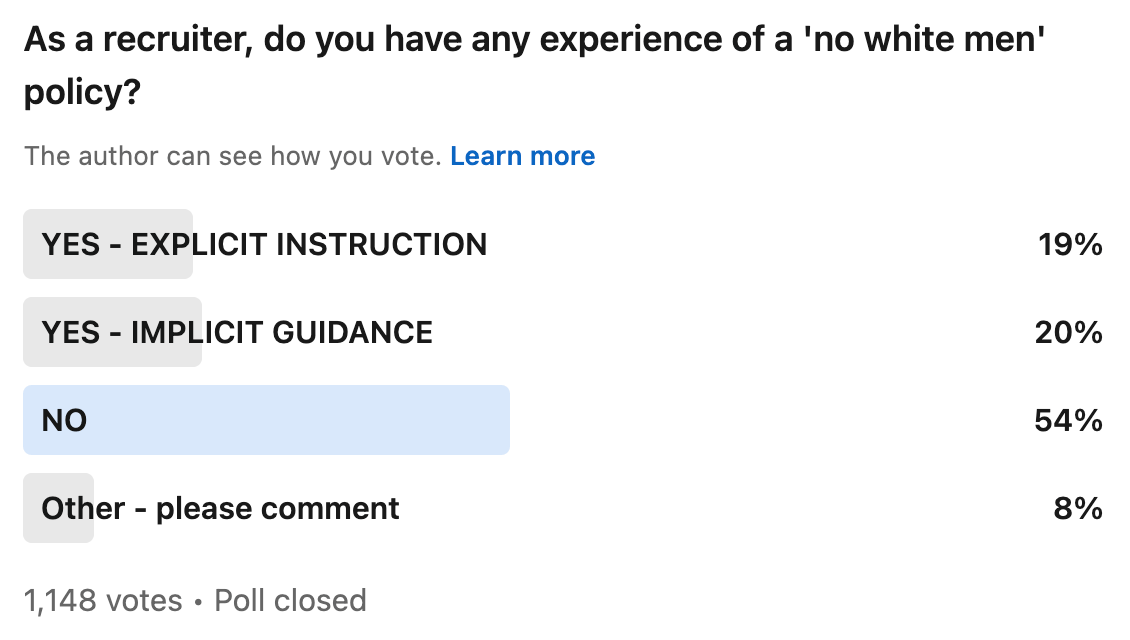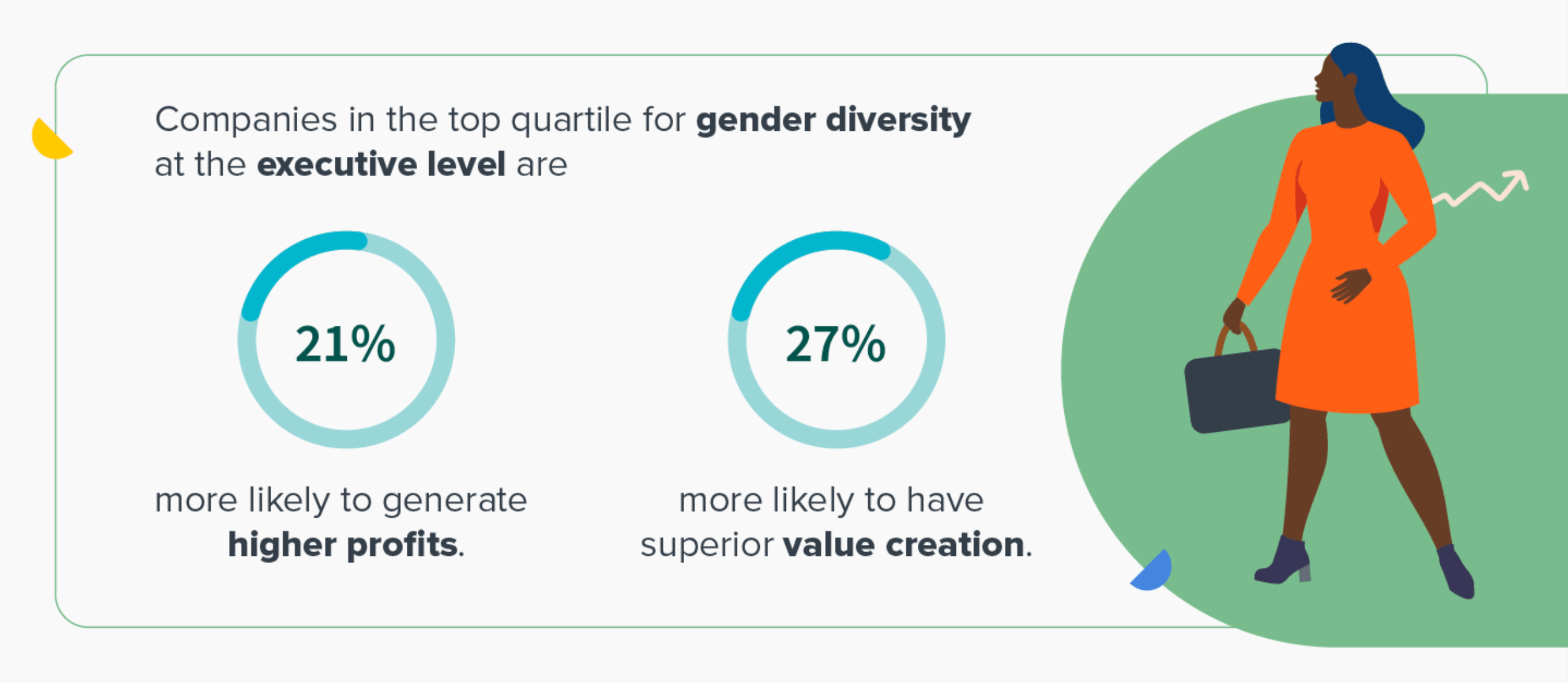‘No white men’ policy: what you can & can’t do in diversity hiring
Explore the intricacies of diversity hiring, where good intentions can sometimes blur lines and explicit policy can run into legal landmines. How can recruiters champion a more inclusive approach without sidelining any demographic?

When tasked with DEI strategy in the recruitment business, you’re not just a recruiter focused on diversity hiring. You’re a mediator balancing the demands of diversity, equity, inclusion, and the ever-present risk of unintentional discrimination. Affirmative action in the United States is now a legally charged topic – and requires careful attention in this area.
Here’s the thing: a recent LinkedIn poll by Hung Lee of Recruiting Brainfood posed an intriguing question to recruiters – have they ever encountered a ‘no white men’ policy? The results are eye-opening:
In short: one in five respondents say they have received explicit instruction for a ‘no white men’ policy. Another one in five say they’ve been implicitly instructed to follow this kind of a policy.
When nearly 40% indicate explicit or implicit experience in being discouraged from hiring from a specific demographic group, that becomes a conversation we need to have. Obviously, it’s more nuanced than a simple ‘yes’ or ‘no’.
In the comments that followed, some did call it discrimination – and explicitly so:
“There are large corporations that are prohibiting white applicants from access to training or promotion, basically sanctioned discrimination. It has been ongoing for a long time. Definitely an issue.”
Others pointed to the good intentions in establishing balance in the hiring process – but called out the legal challenges:
“Yes, we do want to diversify the talent pipeline. No, we do not have a ‘no white men’ policy. But it is extremely hard to create opportunities for women in a male-dominated profession, especially because we operate in a male dominated industry. So how to communicate in a legal way ‘We want more female engineers cos we think it’s gonna be really good for the business and all.’ without being discriminative? 😰 😟 🙄”
“How to communicate in a legal way ‘We want more female engineers cos we think it’s gonna be really good for the business and all.’ without being discriminative?”
Other commentators suggested that policies are not the way to ‘solve’ gender imbalance – instead, they noted the challenge of diversity hiring in specific sectors and industries:
“Positive discrimination is still discrimination. Just hire based on skills. Whether you’re male or female, should not matter. And it just happens so that men tend to like certain professions/sectors more than women and vice versa.”
Another noted that the existing imbalance in the talent market should be addressed at the grade school level, not in the hiring stages for a company. Ultimately, it’s about the long game and it’s not something employers can realistically solve:
“We’ve got to be realistic, you can’t strive for a 50:50 split for male and female engineers in your organisation until the number of engineers in the industry is evenly split. We need to take a medium-to-long term approach and encourage our female engineers and our engineers that are ‘non-white’ to go back to the schools they went to, not universities or colleges, but the schools they went to and talk about engineering as a career there. Until we have an equal amount applying to colleges and universities for these courses then the numbers will be always skewed towards the white male candidate.”
One commentator suggested focusing on fostering equal representation in the form of allyship – and having strategies in place to ensure that:
“There’s a difference between explicitly excluding groups versus making efforts to promote diversity. I have worked for a company that mandated a shortlist [that] had to have at least one ‘diverse’ candidate. Nobody was excluded, but extra efforts were made where necessary to ensure that the slate presented to the hiring manager had at least 1 qualified person who was from an under-represented group. This was only a part of the organisation’s drive to increase diversity, there was also focus on developing internal talent and succession planning, and leadership and HR focus on teams and managers that were not meeting the organisation’s own internal benchmarks for diversity.”
Ensuring a diverse range of candidates was also highlighted as an important strategy:
“I always recommend recruiting strategies that enforce diverse pools (beyond just race; inclusive of experience level/similar skillsets or industries/internal talent etc) before proceeding with final interviews. This intentionally creates space for a wealth of experiences and perspectives for the interviewers consider in making their decision, while also avoiding favoritism for one group or demographic over another.”
And finally, diversity is nuanced beyond gender and race:
“I’m a white male. I’m also a diverse candidate when it comes to several parameters (neurodiverse, bisexual and no longer living in the country I was born). I never say that to pick in a spot for other diverse candidates, because I’ve had it easy. But in the hope it makes people think differently about diversity, what makes us different and how we can talk about diversity.”
How do you establish diversity, then?
So, when your organization emphasizes the importance of diversity and it falls on you as a recruiter to make a difference, what can you do? The many nuances and variations in hiring strategy already are a lot to unpack, and it gets more complex when diversity enters the picture.
Let’s agree on one thing from all the noise in LinkedIn: most do think that diversity is important. Not only is it a clear moral imperative, as 50.6% of respondents in a recent Workable survey say, there’s also a clear business case for diversity, particularly in leadership according to McKinsey.
But, obviously, an up-front ‘no white men’ policy isn’t going to cut it morally or legally. That beign said, you can still progress with good intentions and results if you establish some clear guardrails. Let’s look at a few of those now.
What you CAN do as a recruiter:
Embrace diversity: Prioritize hiring from various backgrounds, experiences, and perspectives without sidelining any group. Focus on the actual diversification – not on restrictions.
Blind or anonymized screening: More firms are moving towards this model, where personal identifiers are removed to combat unconscious bias. The Canadian government, for instance, saw a measurable increase in screen-in rates for minorities via an anonymized recruitment pilot project.
Continuous learning: Just as the workplace evolves, so must our knowledge. This means L&D for inclusive leadership, unconscious bias trainings, and other initiatives designed to establish a more level playing field.
What you CAN’T do as a recruiter:
No blanket exclusions: It’s unlawful to exclude a group based on race, gender, religion, etc. EEOC regulations are no joke.
No strict quotas: While targets can guide, hiring solely to fill a quota can be both ethically and legally problematic.
No assumptions: Every candidate is unique. Making assumptions based on background or identity is counterproductive.
We’re all in the game together
Championing diversity does have a consensus across the board – 93% of respondents say DEI is important to them, according to the above-mentioned Workable survey.
But Hung Lee’s poll shows us the complex quagmire we’re working through right now. While diversity hiring is not necessarily a new concept, it’s not matured to the point where we can all agree on best practices (yet).
One thing’s pretty clear, though – no group can be sidelined, regardless of whether they’re overrepresented or not. It’s a mess you don’t want to get yourself into.
Instead, focus on the big-picture goal – and establish a recruitment process that’s fair, transparent, and beneficial for all involved.
Frequently asked questions
- What is the current sentiment on 'no white men' hiring policies?
- While some recruiters have encountered such policies, they remain controversial. Nearly 40% have experienced discouragement from hiring specific demographics, highlighting a complex issue in diversity hiring.
- Is positive discrimination a viable solution?
- While some view positive discrimination as a way to balance representation, critics argue that hiring should be based purely on skills, regardless of gender or race.
- How can recruiters promote diversity without sidelining any group?
- Focus on hiring from diverse backgrounds and experiences, employ blind or anonymized screening to combat unconscious bias, and engage in continuous learning around inclusive leadership and unconscious bias.
- Are quotas a recommended practice in diversity hiring?
- While targets can guide, hiring solely to fill a quota can be both ethically and legally problematic. It's essential to prioritize skills and experience.
- Why is diversity hiring essential for businesses?
- Apart from being a moral imperative, there's a clear business case for diversity, especially in leadership. Diverse teams often bring varied perspectives, fostering innovation and better decision-making.






